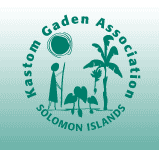|
History of the Kastom Gaden Association... Page updated |
EVALUATIONSWOT: strengths, weaknesses, opportunities, threats...As part of the monitoring report, a SWOT (Strengths/ Weaknesses/ Opportunities/ Threats) matrix was prepared to provide a quick summary on influences on the Kastom Garden Program at the time. SWOT analysis is a technique widely-used in development assistance and business circles to provide an overview and discern trends in a project or organisation. Information brainstormed and entered into a SWOT matrix can provide points to explore later. The brainstorm process can throw up unexpected factors, especially considering it is a shared, participatory process. FindingsStrengthsThe strengths of the KGP were found to include:
WeakessesThe KGP experienced a number of weaknesses including:
OpportunitiesStaff knew that the existence of opportunities did not imply that there would be sufficient resources to take advantage of every one. Opportunities would be characteristically be assessed as to their viability, given the capacity of the program. Those found to be viable would then be prioritised if the decision to move on them was made. Opportunities identified included:
The idea of generating small amounts of cash from farm gate sales was trialed when Australian development worker, Emma Stone, spend several months with the program in 1998. Although sales were made and the potential to produce vegetables and eggs for sale at Honiara Central Market was considered, it was a lack of staff time which made the option unviable. The waste-to-resource project - essentially a green waste composting operation - failed to materialise when the person behind it moved to another island. Enquiries were successfully made in Australia about finding expertise to advise on the project. ThreatsThreats are those factors which could close down or severely limit the program. Frequently, threats will come from outside the program and staff will have no opportunity to influence the threat. Sometimes, however, threats can come about through the worsening of a weakness within a program. The identification of threats can lead to the development of contingency plans in case the threat materialises. Threats facing the KGP were identified as:
Funding shortfall at times threatened the curtailment of program activity, but sufficient funds were found to continue. The KGP entered a more stable period of funding when APACE obtained programme agency status with AusAID which provided more flexibility in the deployment of funds. Evaluation page 1: assessing the programme |
|
© 2007 Kastom Gaden Association | PO Box 742 Honiara SOLOMON ISLANDS | P: 677 39138 | F: 677 30840 | |



